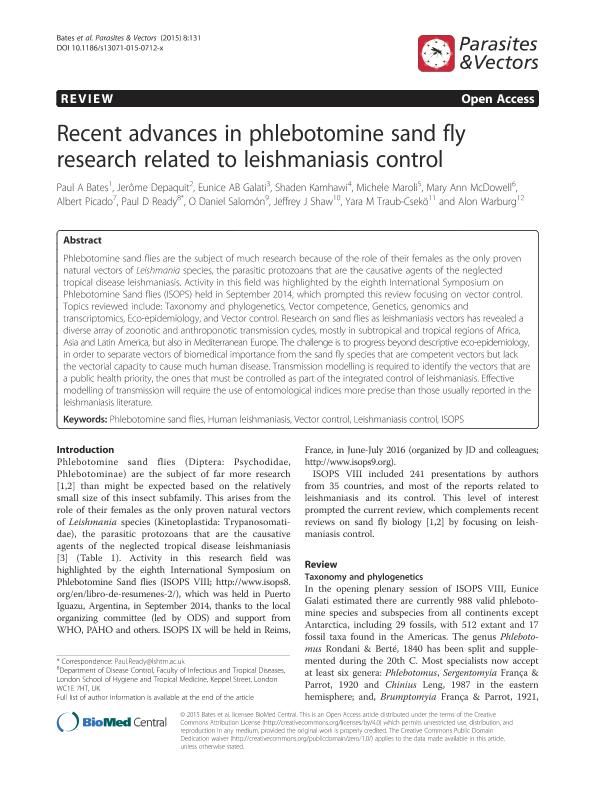Mostrar el registro sencillo del ítem
dc.contributor.author
Bates, Paul A.
dc.contributor.author
Depaquit, Jerôme
dc.contributor.author
Galati, Eunice A. B.
dc.contributor.author
Kamhawi, Shaden
dc.contributor.author
Maroli, Michele
dc.contributor.author
Mcdowell, Mary Ann
dc.contributor.author
Picado, Albert
dc.contributor.author
Ready, Paul D.
dc.contributor.author
Salomon, Oscar Daniel

dc.contributor.author
Shaw, Jeffrey J.
dc.contributor.author
Traub Cseko, Yara M.
dc.contributor.author
Warburg, Alon
dc.date.available
2017-03-15T15:47:58Z
dc.date.issued
2015-01
dc.identifier.citation
Bates, Paul A.; Depaquit, Jerôme; Galati, Eunice A. B.; Kamhawi, Shaden; Maroli, Michele; et al.; Recent advances in phlebotomine sand fly research related to leishmaniasis control; BioMed Central; Parasites & Vectors; 8; 131; 1-2015; 1-8
dc.identifier.issn
1756-3305
dc.identifier.uri
http://hdl.handle.net/11336/13890
dc.description.abstract
Phlebotomine sand flies are the subject of much research because of the role of their females as the only proven natural vectors of Leishmania species, the parasitic protozoans that are the causative agents of the neglected tropical disease leishmaniasis. Activity in this field was highlighted by the eighth International Symposium on Phlebotomine Sand flies (ISOPS) held in September 2014, which prompted this review focusing on vector control. Topics reviewed include: Taxonomy and phylogenetics, Vector competence, Genetics, genomics andtranscriptomics, Eco-epidemiology, and Vector control. Research on sand flies as leishmaniasis vectors has revealed a diverse array of zoonotic and anthroponotic transmission cycles, mostly in subtropical and tropical regions of Africa,Asia and Latin America, but also in Mediterranean Europe. The challenge is to progress beyond descriptive eco-epidemiology, in order to separate vectors of biomedical importance from the sand fly species that are competent vectors but lack the vectorial capacity to cause much human disease. Transmission modelling is required to identify the vectors that are a public health priority, the ones that must be controlled as part of the integrated control of leishmaniasis. Effective modelling of transmission will require the use of entomological indices more precise than those usually reported in the leishmaniasis literature.
dc.format
application/pdf
dc.language.iso
eng
dc.publisher
BioMed Central

dc.rights
info:eu-repo/semantics/openAccess
dc.rights.uri
https://creativecommons.org/licenses/by-nc-sa/2.5/ar/
dc.subject
Phlebotomine Sand Flies
dc.subject
Human Leishmaniasis
dc.subject
Vector Control
dc.subject
Leishmaniasis Control
dc.subject
Isops
dc.subject.classification
Medicina Tropical

dc.subject.classification
Ciencias de la Salud

dc.subject.classification
CIENCIAS MÉDICAS Y DE LA SALUD

dc.title
Recent advances in phlebotomine sand fly research related to leishmaniasis control
dc.type
info:eu-repo/semantics/article
dc.type
info:ar-repo/semantics/artículo
dc.type
info:eu-repo/semantics/publishedVersion
dc.date.updated
2017-02-06T14:25:57Z
dc.journal.volume
8
dc.journal.number
131
dc.journal.pagination
1-8
dc.journal.pais
Estados Unidos

dc.description.fil
Fil: Bates, Paul A.. Lancaster University. Faculty of Health and Medicine. Division of Biomedical and Life Sciences; Reino Unido
dc.description.fil
Fil: Depaquit, Jerôme. Université de Reims Champagne-Ardenne; Francia
dc.description.fil
Fil: Galati, Eunice A. B.. Universidade de São Paulo. Faculdade de Saúde Pública. Departamento de Epidemiologia; Brasil
dc.description.fil
Fil: Kamhawi, Shaden. National Institutes of Health. National Institute of Allergy and Infectious Diseases; Estados Unidos
dc.description.fil
Fil: Maroli, Michele. Istituto Superiore di Sanità; Italia
dc.description.fil
Fil: Mcdowell, Mary Ann. University of Notre Dame. Department of Biological Sciences. Eck Institute for Global Health; Estados Unidos
dc.description.fil
Fil: Picado, Albert. Universidad de Barcelona; España
dc.description.fil
Fil: Ready, Paul D.. London School of Hygiene and Tropical Medicine. Faculty of Infectious and Tropical Diseases; Reino Unido
dc.description.fil
Fil: Salomon, Oscar Daniel. Consejo Nacional de Investigaciones Científicas y Técnicas; Argentina. Ministerio de Salud. Instituto Nacional de Medicina Tropical; Argentina
dc.description.fil
Fil: Shaw, Jeffrey J.. Universidade de São Paulo. Biomedical Sciences Institute; Brasil
dc.description.fil
Fil: Traub Cseko, Yara M.. Instituto Oswaldo Cruz. Laboratório de Biologia Molecular de Parasitas e Vetores; Brasil
dc.description.fil
Fil: Warburg, Alon. Institute of Medical Research Israel-Canada; Israel
dc.journal.title
Parasites & Vectors
dc.relation.alternativeid
info:eu-repo/semantics/altIdentifier/doi/http://dx.doi.org/10.1186/s13071-015-0712-x
dc.relation.alternativeid
info:eu-repo/semantics/altIdentifier/url/http://parasitesandvectors.biomedcentral.com/articles/10.1186/s13071-015-0712-x
Archivos asociados
